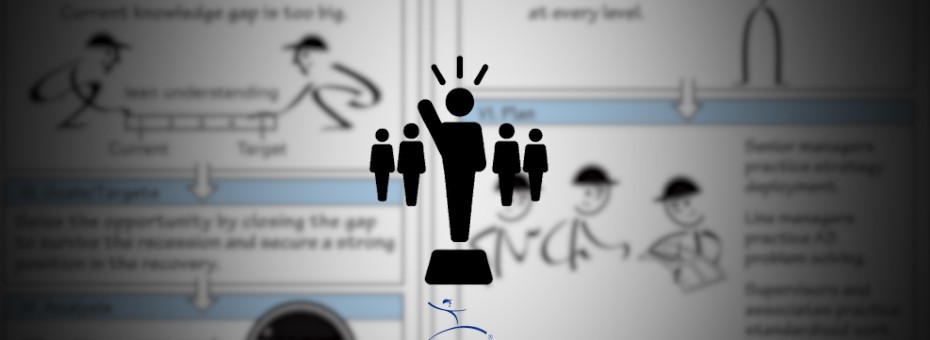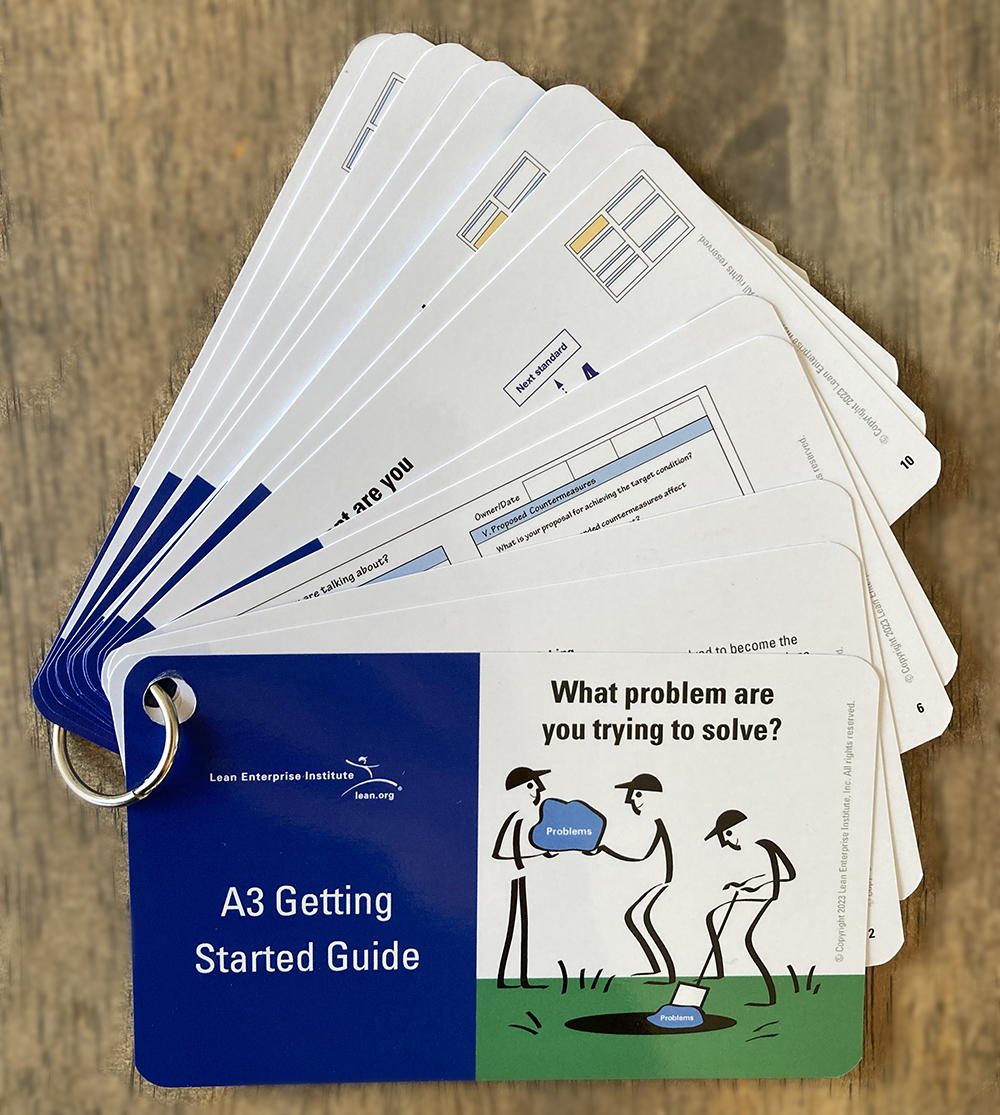Several hundred managers and continuous improvement professionals attended the Lean Enterprise Institute webinar Beyond Problem-Solving: Other Facets of the A3 Process You Should Know and Practice with presenter and coach David Verble. He couldn’t get to a few key questions during the webinar hour, so he’s tackled them in follow-up articles on the Lean Post. The final one follows with links at the end to the webinar and previous answers along with recommendations for learning more. Make sure you are subscribed to the Lean Post and our free newsletters to get the latest alerts about webinars and other content.
Q: How do you introduce A3 thinking to an organization where leaders or managers are not engaged in the A3 process and there is no culture of respect for people and their ideas?
David: You can’t get there from here. If managers and leaders are not experienced and engaged, then they’re going to do things that shut down problem-solvers attempting to talk about their challenges using the A3 format. They’ll disrespect people by challenging them on what they say and by telling them what they should think instead. They will tend to ask leading questions that point the problem-solver toward what the leader thinks they should be doing. It doesn’t sound much different from the cultures in most organizations.
If managers and leaders are not experienced and engaged, then they’re going to do things that shut down problem-solvers …For example, I worked with a company that had several small plants located nearby in a small city. I was working with the plant managers, primarily, but their continuous improvement leads were also part of the program. I asked each of the managers to write on a sheet of flip chart paper what was one problem down in their organization that they really felt some urgency to solve.
Because the city was small, I gave them an hour and 15 minutes to go to their plants, go to the site of the problems they listed, spend half an hour observing what was happening, then another half hour asking questions of the people who dealt with the problems. When they came back, I asked them to write their understanding of the problem next to what they had posted originally. All the plant managers reported that the problems were different from what they had thought.
The reality is that in most cases, unit managers, department heads, senior executives, and CEOs do not really know what’s going on in problem situations in the value-creating work streams in their operations. But they assume they do. What they know in most cases is based on past experience, historical information, pattern recognition, or intuition. They very likely don’t know the reality of problems happening now like the people dealing with them do.
But from their assumptions, leaders and managers do things, say things, tell things, that are destructive to the problem-solving efforts of people down in the organization. They aren’t intentionally disrespectful, but they end up being disrespectful. And they end up creating an environment where people down in the organization don’t feel safe to share what they’re seeing, what they’re concerned about, or ideas about what’s going on or what to do. It doesn’t take much of that kind of behavior to shut down the willingness of people to do problem-solving and create A3s proposing solutions. That’s why I say you can’t get there from here.
Editor: David, what initiative can the person who asked this question take? If he or she has some sort of responsibility in a unit or an area, shouldn’t they try to introduce A3 thinking there?
David: So, here’s the complicating factor. Without individual coaching, people tend to make the same assumptions that leaders make – that they “know.” There has to be a coach who can ask him or her things like, “Well, what did you see that made you think that? What do other people there say is going on?”
We think we know more than we know. The vast majority of what we think is fact is based on impressions, intuitions, or assumptions. There’s nothing wrong with that but they have to be backed up by going to the gemba — to the site of the problem – observing it yourself, talking to people who deal with the problem daily, and collecting data. We don’t think to do those things because we have such calm confidence in our assumptions. And that’s the role of a coach.
Editor: So, you have to have that coach to introduce the A3 problem-solving process properly?
David: You have to have a coach who can recognize the need to ask those questions because we tend to tell ourselves a story about what’s going on that’s not necessarily what’s actually going on at the problem site. It’s human nature. Somebody has to poke holes in those assumptions by asking open-ended questions about, “How do you know that? What leads you to think that? What else did you hear?”
You have to have a coach who can recognize the need to ask those questions because we tend to tell ourselves a story about what’s going on that’s not necessarily what’s actually going on at the problem site.
Questions like those make a person stop, think, and hopefully, go back to get additional and better information. The coach needs to help people frame their assumptions and intuitions as rapid learning experiments and to approach them with an open mind.
Let me add one more element about coaching. In the late 1980s and early 1990s, I was involved in developing education programs to introduce Toyota’s problem-solving process to North American employees and leaders. In Japan, this was done through on-the-job development as described in the Managing to Learn book.
We created a series of A3 courses for North American leaders and managers. And what we found was there was a limit to what you could do with education alone in a classroom. You really did not learn how to do A3 problem-solving until you tried to apply what you learned, ideally with a coach to help you recognize where you were coming close and where you weren’t.
The problem was that in North American Toyota, everybody was learning at the same time, so there was nobody to coach. In the early days, we had Japanese leaders in the plants who could do some coaching despite language differences. But after that, unfortunately, North American management was often not able to do coaching because they hadn’t had enough experience with the process themselves.
Toyota introduced the Toyota Way and Toyota Business Problem Solving in 2005 as cascading training programs. North American executives went through a workshop that I helped develop based on documentation of Toyota business problem-solving in Japan. Each participant had to create an A3 and present it to a panel of senior Japanese leaders for review and coaching. They could not “graduate” until they had created an A3 that the committee of senior leaders deemed acceptable based on evaluation criteria.
After the senior North American leadership completed the workshop, their direct reports went through the program with the same requirement to produce an A3. The executives who had completed the program became the coaches and reviewers for the next level. It cascaded on down through the organization to the supervisor and specialist levels. A coach had to sign off on the A3 before the learner could present it. So, there was a bit of pressure on a leader because his or her name was on the A3 along with the person who created it. It was pretty intensive.
I believe this cascading process that Toyota established for North America and its other overseas operations demonstrates that they recognized that a hands-on, fact-based process like their Business Problem-Solving has to be learned through the help of coaches. These coaches need to have the experience to ask questions that can help learners get past our tendency to assume “we know” and seek to learn the actual conditions of problem situations.
Do These to Keep Learning:
- Watch the free webinar by David, Beyond Problem-Solving: Other Facets of the A3 Process You Should Know and Practice
- Read his answers to follow-up questions from webinar attendees:
Managing to Learn
An Introduction to A3 Leadership and Problem-Solving.






